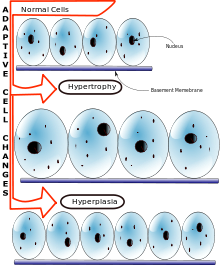This article may lack focus or may be about more than one topic. (December 2021) |
| Hyperplasia | |
|---|---|
 | |
| Whereas hypertrophy stems from an increase in cell size, hyperplasia results from an increase in cell number. | |
| Specialty | Pathology |
| Types | Benign prostatic hyperplasia, Hyperplasia of the breast(many more)[1][2] |
| Diagnostic method | Biopsy[3] |
| Treatment | Depends which type (see types) |
Hyperplasia (from ancient Greek ὑπέρ huper 'over' + πλάσις plasis 'formation'), or hypergenesis, is an enlargement of an organ or tissue caused by an increase in the amount of organic tissue that results from cell proliferation.[4] It may lead to the gross enlargement of an organ, and the term is sometimes confused with benign neoplasia or benign tumor.[5]
Hyperplasia is a common preneoplastic response to stimulus.[6] Microscopically, cells resemble normal cells but are increased in numbers. Sometimes cells may also be increased in size (hypertrophy).[7] Hyperplasia is different from hypertrophy in that the adaptive cell change in hypertrophy is an increase in the size of cells, whereas hyperplasia involves an increase in the number of cells.[8]
| -plasia and -trophy |
|---|
|
|
- ^ Cite error: The named reference
citewas invoked but never defined (see the help page). - ^ Cite error: The named reference
cite2was invoked but never defined (see the help page). - ^ Dunphy LM, Winland-Brown JE (April 2011). Primary Care: The Art and Science of Advanced Practice Nursing. F.A. Davis. ISBN 978-0-8036-2647-8.
- ^ "Hyperplasia". MedlinePlus Medical Encyclopedia. National Library of Medicine, U.S. Department of Health and Human Services National Institutes of Health. Retrieved 2015-05-30.
- ^ Sembulingam K, Sembulingam P (September 2012). Essentials of Medical Physiology. JP Medical Ltd. ISBN 9789350259368.
- ^ Zachary JF, McGavin MD (December 2013). Pathologic Basis of Veterinary Disease. Elsevier Health Sciences. ISBN 978-0-323-29172-9.
- ^ Braun CA, Anderson CM (2007). Pathophysiology: Functional Alterations in Human Health. Lippincott Williams & Wilkins. p. 17. ISBN 978-0-7817-6250-2.
- ^ Rubin E, Reisner HM (2009). Essentials of Rubin's Pathology. Lippincott Williams & Wilkins. ISBN 978-0-7817-7324-9.